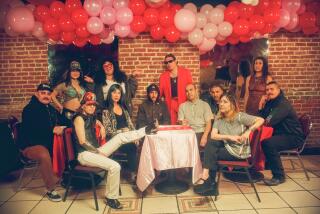Tales From the Edge : It’s an ugly world out there. That’s why Maria Hinojosa listens to teen-age ‘crews.’
Maria Hinojosa was a bored teen-ager in Chicago scanning the radio dial when she first stumbled upon National Public Radio.
“It was a story on Latin America, and I thought, ‘Oh my God, the disc jockeys are not yelling at me. They are talking to me intelligently,’ ” she recalled. “The seeds were planted right there.”
Nearly 20 years later, Hinojosa is the one on the radio talking intelligently to America as a New York-based correspondent for NPR. She hosts “Latino USA,” NPR’s weekly journal of news and culture; WNBC-TV’s public affairs program “Visiones,” and is a frequent guest of “CNN and Company.”
“I knew I could talk to people and get them to tell me things they weren’t telling other people,” said Hinojosa, 33, of her motivation to go into broadcasting after graduating from Barnard College with degrees in Latin American studies and political economics. “What really motivates me is doing stories that no one has heard before--that they should be hearing--and taking them there.”
One of those stories was on New York “crews,” loose-knit bands of youths who insist they are not gang members, although they can be as violent. In September, 1990, a crew mugged a Utah family visiting New York, killing a teen-ager who had tried to protect his mother. News reports said the youths wanted money to go dancing.
Hinojosa wanted to know what made it so easy for a teen-ager to pull out a knife and stab someone. She hit the streets and came back with a radio report that aired on the national program “All Things Considered.” In it, teen-aged boys and girls spoke in compelling, often shocking, voices of their struggle to survive in a confusing society, which for many has been violent since early childhood.
That report was the basis for Hinojosa’s book, “Crews,” published in January by Harcourt Brace. It further elaborates on the young men and women who live on the edge of despair and violence.
*
Hinojosa was initially hesitant to take on the project.
“I was never convinced that I could write. It was not my mother tongue,” said Hinojosa, who was born in Mexico City and moved with her family to Chicago when she was 3. “But I finally feel that I can manejar (manage) both languages 100%.”
She decided to write the book after an editor told her that the kids’ stories needed to be heard, and that she was the one who could get them to talk.
“I feel that young kids often don’t have anyone talking to them and asking them what they think and how they feel about things,” she said. “As a journalist, this was a chance to spend hours and hours with a subject and establish a relationship with them.” Her husband, multimedia artist German Perez, shot photographs for the book.
It was released at a time when the subject of wayward young people, particularly “tagging crews” who spray-paint graffiti, had again drawn national attention. The January shooting death of an 18-year-old tagger in the San Fernando Valley by William Masters--who said he killed in self-defense--triggered a storm of debate.
“My book is not a solution to the problem,” Hinojosa said. “What I am doing is giving these kids a chance to speak their minds so we can hear their logic and have some understanding to help them and help ourselves. These kids are critical, thinking people whose lives are savable if we want.”
Earlier this month at a women’s conference at California Lutheran University in Thousand Oaks, Hinojosa told a gathering of about 1,000 that as women and mothers, they should not tolerate Masters calling the dead youth’s mother an “irresponsible, uncaring parent.”
“He was someone’s son, and (Masters) had the gall to insult his mother,” she said of Masters killing 18-year-old Oscar Rene Arce. “So what should we as women do? Shouldn’t we be on the mother’s side and understand her mourning, and talking against this vigilantism? Isn’t it true that taking a life poses a greater danger than someone writing graffiti on a wall?”
And about multiculturalism, Hinojosa, a petite woman who speaks four languages, said: “In this country we are often all about negation, about denial, and more recently, about fear. Diversity should not be the cause of fear. As a woman of color, I’m profoundly distrusted. I’m often seen as a reporter with an agenda, someone who has an ax to grind, or as that cute little Chiquita Banana. But my way of seeing the world is just as valid as anyone else’s.”
Those comments did not sit well with many in the predominantly white, conservative audience. But Kathryn Swanson, co-chair of the conference and director of women’s programs at CLU, said Hinojosa was invited to deliver the keynote address to broaden the group’s horizons.
“We specifically wanted a woman of color who could speak to us about women’s issues as well as multicultural issues, and she fit the bill so well,” Swanson said. “This has opened up a lot of new ideas and made us look at things through new lenses.”
*
Hinojosa went through her own metamorphosis in 1989, when she finally turned in her Mexican passport to become a U.S. citizen.
“I finally acknowledged that I was going to be in this country forever and that I could never live in Mexico City again,” she said, citing the city’s notorious smog as one factor of many. “I also needed to take responsibility for my own activism and become part of this country and exercise that right to vote.
“Having my Mexican passport was very important to me, but my husband--who is a legal resident from the Dominican Republic and has begun the process to also become a citizen--and I realized that we are citizens of this country and that our children will be born in this country, and we will all be Latino citizens of this country. We realized that we are an integral part of this country as opposed to the notion that we are from ‘back there.’ This is our homeland.”
It is with that same vigor that Hinojosa seeks out stories that will get people to see themselves and issues differently. “I’ve covered a lot of big stories,” Hinojosa said. “The World Trade Center bombing trial, plane crashes, elections and the crisis in Cuba--they are interesting, but I’d rather be covering something like white racist gangs or youth issues. “I want to do the stories no one else is doing, and I think those stories come from just talking and listening to different kinds of people, and hearing what is important to them.”
More to Read
Sign up for Essential California
The most important California stories and recommendations in your inbox every morning.
You may occasionally receive promotional content from the Los Angeles Times.










